 NEWS NEWS
TAXICAB HACK-UP SPECIFICATIONS
§3-01
Vehicle Hack-Up and Vehicle Transfer
§3-02 Vehicle Retirement
§3-03 Taxicab Specifications on or after March 1, 1996
§3-03.1 Hybrid Electric Taxicab Specifications
§3-04 Taximeter Specifications
§3-05 Air Conditioning Specifications
§3-06 Specifications for the Collection and Transmission of Required
Trip Data
§3-07 Passenger Information Monitor
§
3-01 Vehicle Hack-Up and Vehicle Transfer.
(a)
“Hack-up” means to outfit a vehicle as a taxicab and obtain
approval from the Commission for that vehicle to serve as a taxicab,
for the first time. Hack-up requires compliance with:
(1)
all specifications, outfitting requirements, and other requirements
of Rule 3-03;
(2)
all vehicle inspection requirements;
(3)
all insurance requirements, meter and meter testing requirements,
marking specifications, and other requirements of the Owner’s
Rules, as set forth in Chapter 1 of these Rules; and
(4)
the requirements concerning a vehicle’s age, as set forth in
subdivisions (b) and (c) of this section.
(b)
Except as otherwise provided in subsection 3-01 (c)* **, a vehicle may
be hacked-up only if it is a new vehicle that meets all of the following
requirements:
(1)
It is purchased in the first sale from a licensed dealer or a manufacturer.
An original of the manufacturer’s certificate of origin (MSO)
or of the certificate of title must be submitted, in addition to relevant
documents of ownership.
(2)
The vehicle must be of the latest model year available from the manufacturer
or of the model year immediately preceding the latest. When a manufacturer
ceases production of a model, then vehicles of the last two model
years may only be hacked-up until September 30 of the calendar year,
two years subsequent to the designated model year. (For example, if
Chevrolet ceases production of the Caprice after the 1996 model, then
a new vehicle of the 1996 Chevrolet Caprice may only be hacked-up
until September 30, 1998.)
(3)
The vehicle must have accumulated fewer than 500 miles traveled, at
the time of hack-up.
*
Note: This subd. (c) was repealed in City Record Jan. 29, 2002 eff.
Feb. 28, 2002. It dealt with an exception to subd. (b) for "…
extreme personal financial hardship ..., such as a catastrophic illness
..."
**
[As reads in the Official Compilation of the Rules of the City of
New York.]
(c)
Upon hack-up, a vehicle may continue in service with the same medallion,
so long as the vehicle passes inspection and has not yet met its retirement
date, as specified in Rule 3-02.
(d)
A vehicle that was hacked-up pursuant to subdivision (b) may be transferred
to another medallion, with the approval of the Commission, only if the
vehicle passes inspection, has not yet met its retirement date as specified
in Rule 3-02, and meets the requirements of either subsection (1), (2),
(3), or (4).
(1)
Repossessions. The title owner at the time of transfer of the vehicle
to another medallion has acquired the vehicle pursuant to a repossession
sale by the previous owner’s purchase money lender, and the
repossession occurs within twenty-four months of hack-up.
(2)
Long-term drivers. The title owner at the time of transfer of the
vehicle to another medallion was a long-term driver of the vehicle,
as defined in Rule 1-01, for at least five months of its operation
under the previous medallion and will be a long-term driver under
the new medallion.
(3)
Same medallion owner or agent. The owner of the medallion or the owner’s
agent transfers the vehicle to another medallion operated by the same
owner or agent.
(4)
Compressed natural gas vehicle. The owner of a medallion or the owner’s
agent may transfer a vehicle fueled by Compressed Natural Gas to any
other medallion owner or owner’s agent.
(e)
Upon inspecting a vehicle to authorize its transfer to another medallion
pursuant to subdivision (f) (a “re-hack”), the Commission
may charge an inspection fee of $50 as well as a $25 fee pursuant to
Rule 1-06.
(f)
*Notwithstanding the foregoing, an Independent Taxicab Owner or a longterm
driver, who is also the owner of a vehicle may apply to the Chairperson
or his/her designee for an extension of the scheduled retirement date
of said vehicle, for a period not to exceed twelve (12) months from
the original retirement date. Such application shall comply with each
of the following conditions:
(1)
The vehicle owner shall submit a request in writing, together with
any supporting documentation, to the Chairperson or his/her designee,
at least thirty (30) days prior to the scheduled retirement date.
This thirty (30) day requirement may be waived by the Chairperson
or his/her designee upon a showing of a significant change in the
vehicle owner's circumstances that occurred within thirty (30) days
of the scheduled retirement date, or for other good cause demonstrated
to the Chairperson.
(2)
The vehicle owner must demonstrate an economic or other personal hardship
which the Chairperson or his/her designee determines would create
an undue burden upon the owner if the extension were not granted.
*
[As reads in the Official Compilation of the Rules of the City of
New York.]
The Chairperson, or his/her designee, may grant an extension of up
to twelve months from the original retirement date. The vehicle must
continue to meet all safety and emissions requirements of the Commission.
The Chairperson or his/her designee shall withdraw any such extension
granted in the event the subject vehicle is determined by the Commission
at any time to be unsafe for operation.
§ 3-02 Vehicle Retirement.
(a)
The following requirements shall apply to all vehicles hacked-up on
or after March 1, 1996:
(1)
A vehicle which is double-shifted and not driven by at least one longterm
driver, as defined in Rule 1-01, for any period of time on or after
March 1, 1997, must be retired from taxicab service and replaced no
later than the scheduled inspection of the vehicle occurring 36 months
after the vehicle was hacked-up.
(2)
All other vehicles must be retired from the taxicab service and replaced
no later than the scheduled inspection of the vehicle occurring 60
months after the vehicle was hacked-up.
(3)
Notwithstanding the foregoing provisions of this subdivision 3-02(a),
any vehicle hacked-up on or after March 1, 1996 which, no later than
six months after hack-up, is dedicated to operate on compressed natural
gas (with a maximum reserve gas tank of five gallons) and which remains
so dedicated thereafter, throughout its operation, has an extension
of its retirement date by twenty-four additional months of taxicab
service.
(4)
Notwithstanding the foregoing provisions of this subdivision §3-02(a),
the retirement date of any vehicle hacked-up on or after March 1,
1996, which is a minivan approved for use as a taxicab by the Commission,
is extended by: (i) twelve additional months of taxicab service if
doubled-shifted and not driven by at least one long-term driver, as
defined in Rule 1-01; or (ii) eighteen additional months of taxicab
service if not subject to Rule 3-02(a)(4)(i).
(b)
The following requirements apply to a vehicle which is in taxicab service
prior to March 1, 1996. Such a vehicle must be retired from service
and replaced with another vehicle no later than as follows:
(1)
Vehicles of model year 1989 or prior model years must be replaced
no later than the scheduled inspection occurring on April 1, 1997,
or next occurring after that date.
(2)
Vehicles of model year 1990 or 1991 must be replaced no later than
the scheduled inspection occurring on August 1, 1997, or next occurring
after that date.
(3)
Vehicles of model year 1992 must be replaced no later than the scheduled
inspection occurring on April 1, 1998, or next occurring after that
date.
(4)
Vehicles of model year 1993 must be replaced no later than the scheduled
inspection occurring on April 1, 1999, or next occurring after that
date.
(5)
Vehicles of model year 1994 must be replaced no later than the scheduled
inspection occurring on April 1, 2000, or next occurring after that
date.
(6)
Vehicles of model year 1995 must be replaced no later than the scheduled
inspection occurring on April 1, 2001, or next occurring after that
date.
(7)
Vehicles of model year 1996 must be replaced no later than the scheduled
inspection occurring on December 1, 2001, or next occurring after
that date.
(c)
Notwithstanding the foregoing provisions of subdivision 3-02(b), if
any such vehicle of model years 1995 or 1996 is dedicated to operate
on compressed natural gas (with a maximum reserve gas tank of five gallons)
no later than April 1, 1997 and remains so dedicated throughout its
operation, the vehicle must be retired from service and replaced with
another vehicle no later than the scheduled inspection occurring on
December 1, 2003, or next occurring after that date.
(d)
The Chairperson may in his or her discretion extend the retirement date
for vintage cars that have been in service as taxicabs for more than
20 years, or for other models that have exceptional aesthetic, historical,
or other interest as the Chairperson may determine, provided that such
vehicles are in service as taxicabs as of March 1, 1996.
(e)
A vehicle which cannot pass inspection must be replaced, regardless
of whether its retirement date has been reached. A vehicle which has
reached its retirement date must be retired, regardless of whether it
may still pass inspection.
§3-03 Taxicab Specifications on or after March 1, 1996.
(a)
Applicability.
(1)
These specifications shall apply to every motor vehicle which is to
be outfitted as a taxicab and approved by TLC for service; on or after
March 1, 1996.
(b)
General Requirements for Review of Vehicle Models.
(1)
The taxi shall conform to all applicable federal and New York State
motor vehicle standards and requirements. Such standards include:
seat belts for each seating position and shoulder belts for each outboard
seating position; front disk brakes; and the vehicle emissions package
requirements of New York State.
(2)
The sponsor, either the manufacturer or his authorized sales agent,
shall certify item by item that the candidate taxi meets all criteria
herein. Where minimum or maximum is specified, the actual values of
the taxi candidate must be given. The sponsor shall provide the Commission
with a Motor Vehicle Manufacturer Association (MVMA) specifications
form; a complete listing of interior dimensions on TLC form J-303
as measured on a bona fide example of the candidate vehicle; a complete
listing of heavy duty equipment for the taxi vehicle; a list indicating
the significance of characters in the Vehicle Identification Number
(VIN); the manufacturer’s repair shop manual for each candidate
vehicle; and, upon request, full size layout drawings of the candidate
vehicle. The sponsor shall provide an EPA Certificate of Conformity
pertaining to the candidate taxi. The sponsor shall at his own expense,
submit a bona fide example of the candidate vehicle for road testing
and detailed measurements by Commission personnel or their authorized
agents for the purpose of making objective judgements of the candidate
vehicle model’s conformance to these specifications.
(3)
After a model has been approved and examples of it are in service,
the TLC reserves the right to require measurements of vehicles to
ensure conformity with the model specifications. The cost of all tests
shall be borne by the sponsor.
(4)
The sponsor shall make provisions to immediately notify the commission
of any vehicle safety recalls. In addition, the sponsor shall make
provisions to have the Commission placed upon the mailing list for
service bulletins and recalls.
(5)
The manufacturer shall provide to the Chairman information as to the
location of the confidential VINs for such model, pursuant to the
manufacturer’s confidentially requirements for the provision
of such information to law enforcement organizations.
(6)
Experimental equipment designed to exceed existing safety standards
is encouraged, but the Commission’s Safety and Emissions Unit
shall be kept fully informed of all such projects involving New York
City taxicabs from inception to completion.
(7)
The TLC reserves the right to approve limited quantities of vehicles
which fail any of these specific rules provided only that the sponsor’s
vehicle is already purpose-built for taxi service, and therefore,
substantially exceeds other criteria, or in the case where the sponsor
wishes to demonstrate certain outstanding virtues that deserve to
be tested in actual taxi service. The TLC further reserves the right
to require detail changes to make a vehicle more suitable for New
York City taxi service.
(c)
Vehicle Specifications.
(1)
The vehicle shall be manufactured with heavy-duty equipment for taxicab,
police or fleet service, except as provided in paragraph (7). There
shall be a term in the VIN or in a body tag, which distinguishes the
taxicab, police or fleet package from the standard sedan on which
it is based.
(2)
The vehicle shall have EPA passenger compartment interior volume index
of at least 107 cubic feet.
(3)
The rear compartment of any sedan approved for use as a taxicab shall
meet the following dimensions as defined by the Society of Automotive
Engineers:
(a)
Minimum effective legroom (L51) must be at least 43 inches.
(b)
Effective headroom (H63) must be at least 37.5 inches.
(c)
The seat depth (L16) must be at least 18 inches.
(4)
The front compartment of any sedan approved for use as a taxicab shall
meet the following dimensions:
(a)
Effective headroom (H61) must be at least 37.5 inches.
(b)
Maximum effective legroom (L34) must be at least 42 inches.
(c)
Total legroom (the sum of L34 and L51) must be at least 85 inches.
(5)
The vehicle shall be equipped with a factory installed air conditioning
system. If the vehicle model has available air conditioning outlets
for the rear seat area, then the vehicle shall be equipped with such
outlets.
(6)
The vehicle may not be equipped with an engine in which the maximum
horsepower exceeds 220.
(7)
The vehicle may be a sedan, which meets the requirements of paragraphs
2 through 6 of this subdivision, and of paragraph (1) of subdivision
(d), or a minivan which has been approved by the Chairperson after
a determination that the vehicle provides adequate safety and comfort
to passengers, and which also meets the requirements of paragraphs
5 and 6 of this subdivision. If the Federal government or the Commission
determines that any of such vehicles must be wheelchair accessible,
then such vehicles shall be wheelchair accessible to the extent of
such Federal or Commission determination and requirements.
(8)
All windows of the vehicle must have a light transmittance of seventy
(70) percent or more, with the exception of the uppermost six (6)
inches of the front windshield.
(d)
Experimental Vehicle Specifications. Due to the limited production plans
for “taxi package” vehicles, as well as an interest in testing
features of standard production vehicles, including minivans, which
are not “taxi package,” the Chairman may conduct an experiment
with vehicles meeting the following minimum specifications. The Chairman
may, at his or her discretion, limit the number of vehicles participating
in the experiment. The Chairman may, at his or her discretion, waive
any particular requirement, if in his judgment the experiment may demonstrate
certain outstanding virtues that deserve to be tested in actual taxi
service. The Chairman shall report to the Commission concerning the
experiment, no later than July 31, 1996.
(1)
The vehicle shall be either a full size or larger four door sedan
or a minivan equipped with at least four doors. Except for vehicles
which are designed to be handicapped accessible, all doors shall open
outward on hinges (not sliding doors), and the vehicle must be capable
of carrying three passengers seated behind the driver. Any space which
would otherwise be available to seat more than three passengers shall
be used instead to provide luggage space.
(2)
The vehicle shall have EPA passenger compartment interior volume index
of at least 107 cubic feet.
(3)
If the vehicle is equipped with shock absorbers, the rear shock absorbers
must be of the heavy duty variety.
(4)
The vehicle shall be equipped with a factory installed air conditioning
system. If the vehicle model has available air conditioning outlets
for the rear seat area, then the vehicle shall be equipped with such
outlets.
(5)
The vehicle may not be equipped with an engine in which the maximum
horsepower exceeds 220.
(e)
Vehicle Modifications for Taxicab Service.
(1)
Paint and Finish.
(i)
The exterior shall be painted taxi yellow, except for trim. Samples
of paint color and code are to be submitted to the Commission for
approval.
(ii)
The front of the taxi, and especially the bumper, should be designed
with strong emphasis on reducing injury to pedestrians. There shall
be no unnecessary projections such as rigid hood ornaments.
(iii)
The vehicle shall be provided with signs in conformance with the
marking specifications, §1-36 of these rules.
(2)
Roof Light, Meter and Seals.
(i)
Provision shall be made for installing and adequately wiring a roof
light of approved design on top of the roof.
(ii)
Suitable wiring shall be provided for a pair of auxiliary turn signal
lamps to be located adjacent to the roof light. These lamps shall
not be activated with the brake lights.
(iii)
A taximeter approved pursuant to Rule 3-04 shall be installed in
a location which facilitates the driver’s operation of it
and any passenger’s reading of the fare without interfering
with the driver’s safe operation of the taxi or the passenger’s
safety and comfort.
(iv)
The taximeter shall be sealed with tamper resistant seals. The Commission
will designate the type of seal, and will apprise the industry of
the required locations for each taximeter approved pursuant to §3-04
of these rules.
(v)
If the vehicle is equipped with a pinion gear, such pinion gear
shall be sealed. The Commission will designate the type of tamper
resistant seal to prevent removal or change of the pinion gear.
(3)
Security.
(i)
An owner shall install a partition that isolates the driver from
the rear seat passengers, in accordance with section 1-17 of these
rules. The purpose of said partition shall be to provide protection
to the driver while ensuring passenger safety and enabling rear
seat passengers to enjoy a clear and unobstructed view of the taxicab
driver’s license, rate card and front windshield.
(A)
The partition shall consist of a transparent portion that shall
extend downward from the ceiling to a point, as recommended by
the Chairperson and approved by the Commission, based upon the
make and model of vehicle in service, that will provide passengers
and drivers with maximum visibility. The transparent portion of
the partition shall be constructed of a bullet-resistant material,
recommended by the Chairperson and approved by the Commission,
which is also clear and scratch-resistant.
(B)
A protective plate shall join the transparent portion of the partition
and extend from the lowest point of the transparent portion of
the partition downward to the floor of the vehicle. The plate
shall be constructed of a bullet-resistant material recommended
by the Chairperson and approved by the*
*
[As reads in the Official Compilation of the Rules of the City
of New York.]
(A)
A means for passengers and drivers to communicate with each other;
(B)
The capacity for the passenger to pay fares, either by cash, or by credit
card if the taxicab is capable of accepting credit card payments, and
for the passenger to receive receipts for payments and transactions,
while the passenger is in the rear passenger compartment.
(iii)
No partition shall be installed unless the design of the partition,
the materials used in its manufacture, and the method of installation
have been recommended by the Chairperson and approved by the Commission
in accordance with the requirements of this paragraph.
(iv)
No vehicle, other than a vehicle which is exempt from the partition
requirements set forth in section 1-17 of these rules, may be hacked-up
after the effective date of this rule unless a new partition has
been installed which complies with these specifications.
(v)
Each taxicab shall be equipped with a new partition which complies
with these specifications no later than its first regular vehicle
inspection conducted on or after November 1, 2005.
(vi)
An owner shall equip all taxicabs with a help or distress signaling
light system in accordance with the following specifications:
(A)
The help or distress signaling light system shall consist of two
turn signal type “lollipop” lights.
(B)
One light shall be mounted on the front center of the vehicle,
either on top of the bumper or forward or behind the grill. A
second light shall be mounted on top of the rear bumper, to the
left of the license plate.
(C)
Each light shall be three to four inches in diameter, have a total
rated output of thirty-two candle power and shall be the color
amber or have an amber colored lens so that the light output of
the device is the color amber at thirty two candle power.
(D)
The activator shall be installed within easy reach of the driver,
shall be silent when operating, and shall be fully solid-state.
(E)
The lights shall flash between 60 and 120 times per minute.
(F)
The wiring shall not affect or interfere directly or otherwise
with any wiring or circuitry used by the meter for measuring time
or distance.
(vii)
A door ajar notification light shall be provided which is located
in front of the driver. This light shall turn on only when any door
is not fully latched.
(4)
Credential Holders.
(i)
A credential holder shall be mounted on the right side of the dashboard,
unless in the judgment of the Chairman, a dashboard mounting would
be hazardous in a particular model of automobile. A model equipped
with dual air bags is a model in which a dashboard mounting would
be hazardous, unless in the judgment of the Chairman there is an
alternative solution to the requirements of subdivision (ii).
(ii)
A vehicle in which a dashboard mounting would be hazardous shall
be equipped with a transparent partition and a protective plate,
in accordance with §3-02(e)(3)(i), and shall have a TLC approved
credential holder frame mounted on the driver’s side of the
clear portion of the partition by either rivet and/or screw at least
two inches above the frame supporting the clear portion of the partition
and centered on the vehicle’s steering column and/or the headrest
on the driver’s seat facing the rear passenger’s compartment.
The frame shall have a drop-in or slide-in slot accessible only
from the driver’s compartment for the rate card and the driver’s
license. The frame shall have sufficient illumination pursuant to
Owners Rule 1-12(a). The frame shall be sufficiently padded so as
not to cause injury to the driver.
(5)
Occupant accommodation.
(i)
There shall be a hold-open device on each door.
(ii)
There shall be a door pull on each rear door. Assist straps shall
be mounted either on each B-pillar or upon the partition. Both the
door pulls and assist straps shall meet the impact requirements
of federal MVSS 201. There shall be no coathook on the right-hand
side.
(iii)
There shall be an outboard armrest located appropriately for the
driver and each outboard passenger.
(iv)
The upholstery and trim shall be vinyl, shall meet federal (MVSS)
standards for flame resistance and shall have a suitable surface
for mounting authorized decals.
(v)
A taxicab may not be equipped with power adjusted seats. A taxicab
may be equipped with either bucket or bench seats, provided that
the seats do not interfere with the partition and do meet all the
requirements of the TLC. All replacement seats must be designed
by the manufacturer for installation in the model and year of the
vehicle in which the seats are installed.
(6)
Repealed.
(7)
Credit Card Acceptance Capability. Each taxicab must be capable of
accepting major credit cards and debit cards as payment for fares.
This specification shall be implemented as agreed upon between the
Taxi and Limousine Commission and the authorized contractor(s) on
a date certain to be set by the Commission.
(8)
Text Message Equipment. Each taxicab must be equipped with equipment
recommended by the Chairperson and approved by the Commission capable
of enabling the driver to receive and send text messages in a format
approved by the Chairperson. No Text Message Equipment shall be installed
unless it has been approved by the Chairperson, based upon a determination
that the equipment conforms with the specifications as set forth herein,
meets appropriate safety standards, and fulfills the intended purposes
for such equipment. No Text Message Equipment shall be used in contravention
of TLC Rules. No Text Message Equipment shall be used for dispatch
purposes. This specification shall be implemented as agreed upon between
the Taxi and Limousine Commission and the authorized contractor(s)
on a date certain to be set by the Commission.
§3-03.1 Hybrid Electric Taxicab Specifications.
(a)
The purpose of this section is to implement section 19-533 of the Administrative
Code, as enacted by local law 72 of 2005.
(b)
As used in this section, the term “hybrid electric vehicle”
shall mean a commercially available mass production vehicle originally
equipped by the manufacturer with a combustion engine system together
with an electric propulsion system that operates in an integrated manner.
(c)
Any hybrid electric vehicle manufactured for the general consumer market
shall be approved for hack-up, as that term is defined in section 3-01(a)
of this chapter, provided that such vehicle is presented for hack-up
on or after the effective date of this rule, and provided that such
vehicle meets all requirements for vehicle hack-up except the following:
(i)
The hybrid electric vehicle shall not be required to be manufactured
with heavy-duty equipment for taxicab, police or fleet service, notwithstanding
the provisions of section 3-03(c)(1) of this chapter;
(ii)
Minimum interior volume index shall be 101.5 cubic feet, notwithstanding
the provisions of section 3-03(c)(2) of this chapter;
(iii)
Minimum effective rear compartment legroom (L51) shall be 34.6 inches,
notwithstanding the provisions of section 3-03(c)(3)(i) of this chapter;
(iv)
Minimum effective rear compartment headroom (H63) shall be 37.1 inches,
notwithstanding the provisions of section 3-03(c)(3)(ii) of this chapter;
(v)
Minimum effective front compartment legroom (L34) shall be 41.6 inches,
notwithstanding the provisions of section 3-03(c)(4)(ii) of this chapter;
(vi)
Minimum total legroom (the sum of L34 plus L51) shall be 76.2 inches,
notwithstanding the provisions of section 3-03(c)(4)(iii) of this
chapter;
(vii)
The maximum horsepower shall be 268, notwithstanding the provisions
of section 3-03(c)(6) of this chapter;
(viii)
The hybrid electric vehicle shall have at least four doors, and shall
be a minivan, a compact or larger sedan, or a sport utility vehicle,
notwithstanding the provisions of section 3-03(c)(7) and (d)(1) of
this chapter; provided that a hybrid electric vehicle designated a
sport utility vehicle by either the vehicle’s manufacturer or
by the National Highway Traffic Safety Administration must be equipped
with running boards;
(ix)
A hybrid electric vehicle designated a sport utility vehicle by either
the vehicle’s manufacturer or by the National Highway Traffic
Safety Administration shall have a rear window and left and right
rear side windows with the greatest degree of light transmittance
available from the manufacturer or by dealer option, but in no event
less than 20 percent light transmittance, notwithstanding the provisions
of section 3-03(c)(8) of this chapter; and
(x)
A partition shall not be required in a hybrid electric vehicle, notwithstanding
the provisions of section 3-03(e)(3)(i) of this chapter; provided
that if a partition is not installed in compliance with section 1-17(a)
of this title, the hybrid electric vehicle shall be equipped with
a digital camera and recording equipment approved by the Commission
pursuant to section 1-17(b)(3) of this title.
(d)
Notwithstanding the provisions of section 3-02 of this chapter, the
retirement date for a hybrid electric vehicle hacked up pursuant to
this section shall be determined as follows:
(i)
A vehicle which is double-shifted and not driven by at least one longterm
driver, as defined in section 1-01 of this title, for any period of
time after hack-up, must be retired from taxicab service and replaced
no later than 36 months after the vehicle was hacked-up.
(ii)
Any other vehicle must be retired from taxicab service and replaced
no later than 60 months after the vehicle was hacked-up.
(iii)
A vehicle hacked-up pursuant to this section shall not be eligible
for any extension of the retirement dates provided in this paragraph.
§3-04 Taximeter Specifications.
(a)
The Unit must:
(1)
be fully electronic.
(2)
have all access points sealed by a licensed N.Y.C. taxi meter shop.
(3)
have casing made of hard impenetrable plastic or metal.
(4)
be capable of operating within a temperature range of –20F and
+120F.
(5)
automatically produce a printed receipt for passengers which indicates
date, time, medallion number, fare paid, extras, and Commission telephone
complaint number. This receipt shall have all readouts in a minimum
of five figures including decimals eg. 000.00.
(6)
be capable of releasing a printed receipt within 10 seconds.
(7)
be capable of producing a printed receipt for Commission personnel
which shows total mileage, total paid mileage, total trips and total
units, and total extras. All these readouts must show a minimum of
six digits exclusive of decimals eg. 999,999. This function shall
be operated by a separate button or switch.
(8)
have all seals indicating on the sealed surface the licensed meter
shop by name and license number. If an adjustment can be made to any
component affecting the performance of the printer, then provision
shall be made for applying a seal in a manner which requires the seal
to be broken before an adjustment can be made.
(9)
have an auxiliary power source which operates independently of the
vehicle’s electrical system contained in the unit and it shall
operate the memory at its full capacity for a minimum of 2 years.
(10)
have a memory which shall be non-erasable. Upon reaching the limits
of any display, the unit shall be capable of turning over.
(11)
have a fully programmable fare structure with low cost rate change
capability.
(12)
for 2 piece units, have a printer capable of interfacing with and
recording information from a fully approved electronic taximeter.
(13) for 2 piece units, have all connections between display meter
and the unit permanently sealed and tamper-proof by use of approved
tubing or electrical conduits. The display unit must be unable to
function if disconnected from the memory unit.
(14)
be capable of automatically making meter display inoperable if printer
paper is not available in the printing unit.
(15)
have model and serial numbers appearing on the face of the unit. For
2 piece units, model and serial numbers must appear on the display
unit and the printer unit.
(16)
all operating buttons and/or switches related to passenger functions
must appear on the face of the unit, must be properly illuminated,
and must indicate its function.
(17)
extras shall appear separately on the display as well as the receipt
for passengers. Extra indicator must be illuminated when in operation.
(18)
fare display shall remain on a total of 15 seconds from the time the
printer begins to print the customers receipt at the completion of
the ride.
(19)
fare display shall be clearly visible.
(20)
receipt disposal unit must be visible to the passenger.
(21)
all illuminated indicators must be of sufficient candlepower to be
visible to the passenger.
(22)
be permanently affixed to the vehicle in a location approved by the
Commission.
(23)
the rooflight must be controlled by the engaging of the meter.
(24)
be capable of calculating and displaying either two alternative rates
of fare. In addition to displaying the rate of fare as required by
Owners Rule 1-70, the meter unit shall also be capable of displaying
instead the flat rate of fare for a trip from Kennedy Airport to Manhattan,
as required by Owners Rule 1-69.
(b)
In addition, taxi meters shall meet the specifications and tolerances
published in the National Bureau of Standards Handbook 44.
(c)
In addition to fulfilling the requirements of subsections 3-03(a) and
(b), each unit must be approved by the State of New York Department
of Agriculture and Markets.
(d)
Each such unit submitted to the Commission for approval will be subject
to the Commission’s normal testing period of three months minimum.
§3-05 Air Conditioning Specifications.
(a)
All vehicles shall be equipped with an air conditioner. The air conditioner
must be in good working condition from May 1st through September 30th
each year. In vehicles equipped with a partition, the air conditioner
shall include either an Auxiliary Unit or a Patch Unit, as required
for various classifications of vehicles by this section.
(b)
An Auxiliary Unit has controls which passengers may operate in the rear
passenger area. It either:
(1)
was built into the vehicle by the vehicle manufacturer; or
(2)
operates off the vehicle’s compressor and by means of a secondary
evaporator core placed in a location approved by the Commission, and
outlets from that evaporator core to provide cool air directly to
the rear passenger compartment; or
(3)
is a unit approved by the Chairperson, based upon a finding in his
or her sole discretion, as to the unit’s equivalence to items
(1) and (2) above in the delivery of cool air to the rear passenger
compartment; its effects on driver and passenger safety; its noise;
and its effect upon passenger comfort and convenience. The Chairperson
may, in his or her sole discretion, permit the trial operation of
units in a limited number of taxicabs, in order to make such a finding.
The Chairperson may terminate the trial and direct the removal of
units used in the trial.
(4)
The Chairperson may attach further conditions and specifications for
any Auxiliary Unit. The Chairperson may require the refitting of taxicabs
equipped with a previously approved Auxiliary Unit, only if such refitting
either: (a) would cost less than $100; or (b) is based upon the Chairperson’s
finding as to a safety hazard.
(c)
A Patch Unit has a conduit from one or more air conditioner vents in
the dashboard into the rear passenger compartment. A Patch Unit must
be approved by the Chairperson, based upon a finding, in the Chairperson’s
sole discretion, as to the unit’s effects on driver and passenger
safety, its sufficiency in the delivery of cool air, its noise, and
other effects upon passenger comfort and convenience. Without limiting
the authority of the Chairperson to approve other units, or to withdraw
or modify the approval of a unit, there are three currently approved
Patch Units:
(1)
The Overhead Patch Unit consists of a commercially available extension
outlet, which is fixed to the vehicle above the partition.
(2)
The Center Patch Unit consists of a duct with an outlet in the metal
portion of the partition. Effective July 3, 1998, this unit shall
not include a fan in the partition outlet, because such a fan may
create air pressure conditions within the duct which adversely affect
the delivery of cool air.
(3)
The Side Patch Unit reroutes the hose(s) to provide cool air conditioning
to vents under the two front seats. The cool air then flows via a
duct to the extreme left and right sides of the partition with an
outlet discharging cool air into the rear passenger compartment.
(4)
The Chairperson may withdraw approval or attach further conditions,
and may require the refitting of taxicabs fitted with the unit for
which approval was withdrawn or further conditioned. Such determination
shall be based upon a finding, in the Chairperson’s sole discretion,
as to the foregoing factors of safety, comfort and convenience. The
Chairperson must provide owners with sixty days notice of any such
refitting requirement and shall report the determination to the Commission.
(d)
All vehicles hack-up or re-hacked on or after July 3, 1998, and equipped
with a partition shall be equipped with an Auxiliary Unit.
(e)
All vehicles hacked-up prior to July 3, 1998 and equipped with a partition
shall be equipped with either an Auxiliary Unit or a Patch Unit.
§ 3-06 Specifications for the Collection and Transmission of Required
Trip Data.
(a)
All vehicles shall comply with the data collection and transmission
requirements of this Section. This specification shall be implemented
as agreed upon between the Taxi and Limousine Commission and the authorized
contractor(s) on a date certain to be set by the Commission.
(b)
Each taxicab shall be capable of transmitting data to the Commission
or its designated repository at pre-determined intervals established
by the Chairperson. All transmissions shall be in a format and manner
approved by the Chairperson. The data to be transmitted shall include
the taxicab license number; the taxicab driver’s license number;
the location of trip initiation; the time of trip initiation; the number
of passengers; the location of trip termination; the time of trip termination;
the metered fare for the trip; and the distance of the trip. All data
transmitted to TLC will be sent in a secure format as approved by the
Chairperson.
(c)
To the extent necessary to facilitate data transfer, the Commission
may mandate that each taxicab be equipped with external antennas.
(d)
No equipment designed to comply with the provisions of this section
shall be installed unless it has been approved by the Commission, based
upon a determination that the unit and equipment conforms with the specifications
as set forth herein, is safe, and fulfills the intended purposes for
such equipment.
§ 3-07 Passenger Information Monitor.
(a)
All vehicles shall be equipped with a Passenger Information Monitor
which meets the requirements of this section. This specification shall
be implemented as agreed upon between the Taxi and Limousine Commission
and the authorized contractor(s) on a date certain to be set by the
Commission.
(b)
The Passenger Information Monitor shall have the following minimum specifications
or capabilities:
(i)
Provide the passenger sitting in the rear of the vehicle with an unobstructed
view of the monitor;
(ii)
Be of a size and construction, and placed in a location as approved
by the Chairperson;
(iii)
Display a map agreed upon between the TLC and the authorized vendor(s)
that indicates the current location of the vehicle as well as the
route the vehicle has traveled from the point of trip initiation to
the point of trip termination;
(iv)
Display only TLC Public Service Announcements (PSAs) including but
not limited to the Passenger Bill of Rights, the Flat Fare Notice
and any other TLC PSAs as designated by the Chairperson and at the
medallion owner’s option, limited media content, which may include
commercial advertising and commercial sponsorships as enumerated in
the contract(s) between the TLC and approved vendor(s);
(v)
Display itemized metered fare information;
(vi)
The capability for the passenger to turn off the monitor to a blank
screen without illumination, after any TLC Public Service Announcements
or any such other required information as designated by the Chairperson,
which may remain visible or illuminated for all or a portion of the
passenger trip. The monitor must also have the capability to re-illuminate
upon disengagement of the meter to further display any additional
TLC PSAs upon the passenger(s) leaving the taxicab. The monitor must
also contain the capability for the passenger to control and/or mute
the volume of content after any TLC Public Service Announcements or
any such other required information as designated by the Chairperson.
(c)
No Passenger Information Monitor or related equipment shall be installed
unless it has been agreed upon between the TLC and the authorized contractor
on a date certain to be set by the Commission based upon a determination
by the Chairperson that the unit and equipment conforms with the specifications
as set forth herein, meets appropriate safety standards, and fulfills
the intended purposes for such equipment.
 NEWS NEWS
RULES GOVERNING ACCESSIBLE TAXICABS
Notice
is hereby given in accordance with section 1043(e) of the Charter of
the City of New York (“Charter”) that the Taxi and Limousine
Commission (“TLC”) promulgates rules governing accessible
taxicabs.
These rules are promulgated pursuant to sections 1043 and 2303(b)(11)
of the Charter and sections 19-503 and 19-532(b) of the Administrative
Code of the City of New York.
These rules were published for public comment in The City Record on
April 6, 2006. A public hearing on these proposed rules was held by
the TLC at its offices at 40 Rector Street, 5th Floor, New York, New
York 10006 on May 11, 2006. Pursuant to section 1043(e)(1)(c) of the
Charter, these rules will take effect 30 days following the publication
in The City Record.
Section 1. Title 35, chapter 3 of the Rules of the City of New York
is amended by adding a new section 3-03.2, to read as follows:
The following material is new:
3-03.2 Accessible Taxicab Specifications.
(a) Definitions. For purposes of this section:
(1) The term “accessible taxicab” shall refer to a taxicab
that complies with federal regulations promulgated pursuant to the
Americans with Disabilities Act applicable to vans under 22 feet in
length, by the federal Department of Transportation, in Code of Federal
Regulations, title 49, parts 37 and 38, and by the federal Architectural
and Transportation Barriers Compliance Board, in Code of Federal Regulations,
title 36, sections 1192.23 et seq., and the Federal Motor Vehicle
Safety Standards, Code of Federal Regulations, title 49, part 571,
that is hacked-up, as that term is defined in section 3-01(a) of this
chapter, to an accessible medallion or any other medallion on or after
June 25, 2006.
(2)
The term “OEM” shall refer to the original equipment manufacturer
of the accessible taxicab who either manufactures the accessible taxicab
in compliance with the specifications in subdivisions (c) and (d)
of this section or manufactures the accessible taxicab such that the
chassis complies with the specifications in subdivision (c)
of this section and approves a second stage manufacturer who modifies
the vehicle to comply with the specifications of subdivision (d) of
this section.
(b)
An accessible taxicab shall be approved for hack-up if:
(1)
It is a vehicle other than a van the chassis for which as originally
manufactured is designed to seat eight or more persons, a bus, or
a minibus;
(2)
It is capable of transporting at least one passenger using a common
wheelchair as defined in Code of Federal Regulations, title 49, section
37.3;
(3) As presented for hack-up, it does not seat more than five passengers
in all; and
(4)
It complies with the requirements stated in subdivisions (c) and (d)
of this section, and all other requirements for hack-up that are not
inconsistent with the provisions of this section; provided, however,
that an accessible taxicab that is also a hybrid electric vehicle
must also comply with the requirements stated in section 3-03.1 of
this chapter.
(c)
The chassis of the accessible taxicab as originally manufactured must
meet the following general OEM specifications:
(1) The maximum horsepower shall be 240;
(2)
The suspension shall utilize the OEM’s suspension and steering
components; and
(3)
No bumper modifications are allowed.
(d)
The accessible taxicab as manufactured by the OEM or as modified by
an OEM- approved second-stage manufacturer must meet the following specifications:
(1)
The minimum ground clearance (measured from frame, loaded to gross
vehicle weight rating (GVWR)) shall be 5 inches;
(2)
The minimum passenger compartment length (measured from rear of driver’s
seat base to rear seat base) shall be 56 inches;
(3)
The OEM floor of the accessible taxicab, if lowered, shall be lowered
from the base of the firewall to the area immediately in front of
the rear axle;
(4)
If a lowered floor assembly is used in the accessible taxicab, it
shall be stainless steel (16 gauge minimum), and shall meet or exceed
the 1000 hour salt spray rating;
(5)
If a lowered floor assembly is used in the accessible taxicab, a vapor-insulating
barrier of 1/2 inch marine grade plywood shall be applied over the
lowered metal floor and thoroughly secured;
(6)
The wheelchair ramp shall not block any part of the door or glass
while in the stowed position;
(7)
The wheelchair securement system shall be provided to hold a wheelchair
or wheelchairs and shall be the system known as Q straint QRT Standard
or equal;
(8)
No anchor points shall project more than 1/8 of an inch above the
finished floor;
(9)
If the accessible taxicab has a middle fold-up passenger seat, it
shall have a folding mechanism and base plate and shall meet the requirements
of the Federal Motor Vehicle Safety Standard No. 207, Code of Federal
Regulations, title 49, section 571.207;
(10) Any modifications to the rear air conditioning must be approved
by the OEM;
(11) Any and all electrical wiring in the accessible taxicab, other
than as provided by OEM who manufactured the chassis, shall be PVC
or better insulated and color coded for positive identification; and
(12)
The back-up alarm in the accessible taxicab shall be an electrically
operated device that produces an intermittent audible signal when
the accessible taxicab’s transmission is shifted to reverse.
(e)
Notwithstanding the provisions of sections 3-01(f) and 3-02 of this
chapter, the retirement date for an accessible taxicab shall be determined
as follows:
(1)
An accessible taxicab which is double-shifted and not driven by at
least one long-term driver, as defined in section 1-01 of this title,
for any period of time after hack-up, must be retired from taxicab
service and replaced no later than 36 months after the vehicle was
hacked-up;
(2)
Any other accessible taxicab must be retired from taxicab service
and replaced no later than 60 months after the vehicle was hacked-up;
and
(3)
An accessible taxicab hacked-up pursuant to this section shall not
be eligible for any extension of the retirement dates provided in
this paragraph.
STATEMENT OF BASIS AND PURPOSE
The
rules provide specifications for taxicabs to be used with accessible
medallions pursuant to section 19-532(b) of the Administrative Code
of the City of New York. The specifications are applicable to taxicabs
that are hacked-up for use with accessible and other medallions on or
after June 25, 2006. The specifications incorporate federal regulations
promulgated pursuant to the Americans with Disabilities Act of 1990
(“ADA”) applicable to vans under 22 feet in length, by the
federal Department of Transportation, Code of Federal Regulations, title
49, parts 37 and 38, and by the federal Architectural and Transportation
Barriers Compliance Board, Code of Federal Regulations, title 36, sections
1192.23 et seq. The purpose of the rules is to ensure that accessible
taxicabs are accessible to passengers who use wheelchairs
The
rules require that an accessible taxicab be a vehicle other than a van
the chassis for which as originally manufactured is designed to seat
eight or more persons, a bus, or a minibus. The vehicle must meet the
specifications either after original manufacture or after modification
by a second-stage manufacturer that is approved by the original manufacturer.
The Taxi and Limousine Commission staff has identified two vehicles
currently in production that meet the specifications – the Chevrolet
Uplander, as modified by Eldorado National and sold as the Amerivan
PT, and as modified by the Braun Corporation and sold as the Braun Entervan.
 NEWS NEWS
VEHICLES APPROVED FOR TAXI HACK-UP
2007
Saturn Vue And Toyota Camry Hybrids Join List Of Approved Taxicab Models
The
New York City Taxi and Limousine Commission (TLC) added two vehicles
to those 2006 and 2007 models already authorized for hack-up as New
York City medallion taxicabs.
These
vehicles are the only vehicles permitted for hack-up as New York City
Medallion Taxis, provided they meet all TLC Rules & Regulations:
2006
Toyota Sienna CE
2006 Ford Crown Victoria – Stretch
2006 Ford Escape – Hybrid
2006 Mercury Mariner - Hybrid
2006 Toyota Prius – Hybrid
2006 Toyota Highlander – Hybrid
2006 Honda Accord – Hybrid
2006 Honda Civic – Hybrid
2006 Lexus RX400H – Hybrid
2007 Saturn VUE Green Line – Hybrid
2007 Toyota Camry Hybrid
The
above named vehicles do not require approval letters from Safety &
Emissions, and must meet all TLC Rules and specifications.
TENTATIVE
LIST OF VEHICLES APPROVED FOR USE WITH ALTERNATIVE FUEL MEDALLIONS—5/31/06
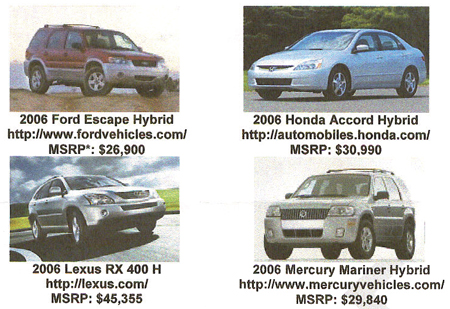
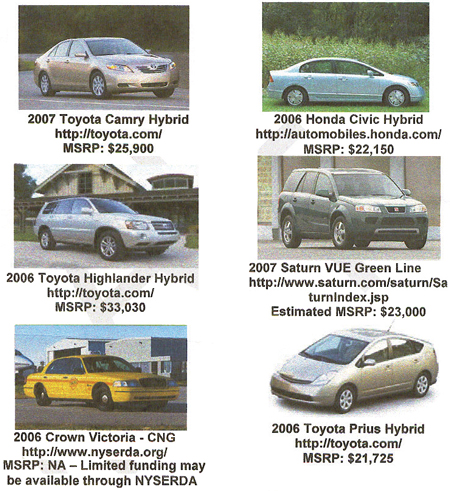
TENTATIVE
LIST OF VEHICLES APPROVED FOR USE WITH ACCESSIBLE MEDALLIONS—5/31/06
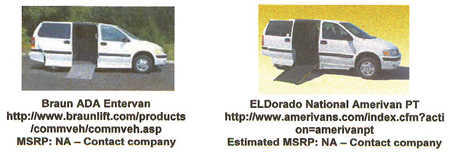
 NEWS NEWS
TLC COMPLETES AUCTION OF 54 ACCESSIBLE NEW YORK CITY TAXICAB MEDALLIONS
The
New York City Taxi and Limousine Commission (TLC) successfully auctioned
54 new taxicab medallions earmarked for use with wheelchair accessible
vehicles. This will bring to 81 the number of New York City taxicabs
capable of offering ramp entry service to wheelchair users.
On
May 23, 2006, Mayor Michael R. Bloomberg, TLC Commissioner Matthew W.
Daus and New York City Council Speaker Christine Quinn announced plans
to seek State legislation that would authorize an additional 150 medallions
earmarked for accessible vehicles.
"As
we had anticipated, these accessible medallions generated tremendous
interest by prospective bidders to the extent that there was an approximate
ratio of ten bids to every one available medallion," said TLC Commissioner/Chair
Matthew W. Daus. "We hope to see these vehicles on the road and
serving the public as quickly as possible."
The
process involved the public opening of sealed bids that were submitted
to the TLC between Tuesday, June 13 and Thursday, June 15. The bid amounts
were read aloud and processed by a team of specially trained TLC staff.
A large screen flashed the ranking of the bids, allowing prospective
new medallion owners to monitor their progress and ultimately determine
whether they prevailed in their effort. The opening took place at the
TLC's 40 Rector Street headquarters, on the sixth floor.
Winning
bidders were invited to attend a bid winner's workshop at TLC headquarters
to become familiarized with the processes and procedures that will assist
them in getting started. The TLC also made expedited medallion closing
and "hack-up" procedures available to winning bidders in order
to facilitate their successful start-up.
PLEASE
NOTE: THE FOLLOWING NUMBERS ARE TENTATIVE AND UNOFFICIAL, PENDING CONFIRMATION
AND PROCESSING
TENTATIVE RESULTS
MEDALLION
AUCTION FAST FACTS
Accessible
Vehicle
•
Highest Winning Bid: $477,666.50
• Lowest Winning Bid: $477,666.50
• Average Winning Bid: $477,666.50
• Total No. of Bids Received: 210
• Number of "Valid" Bids: 210
• Number of "Below Bid" Bids: 0
• No. of "Incomplete" Bids: 0
• No. of Independent Bids: 7
• No. of Minifleet Bids: 203
N.Y.C.
T.L.C. CLOSED BID AUCTION TENTATIVE RESULTS: RESTRICTED (ACCESSIBLE) MEDALLIONS

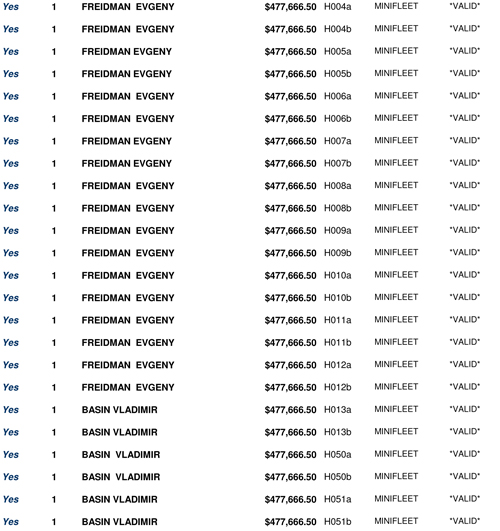

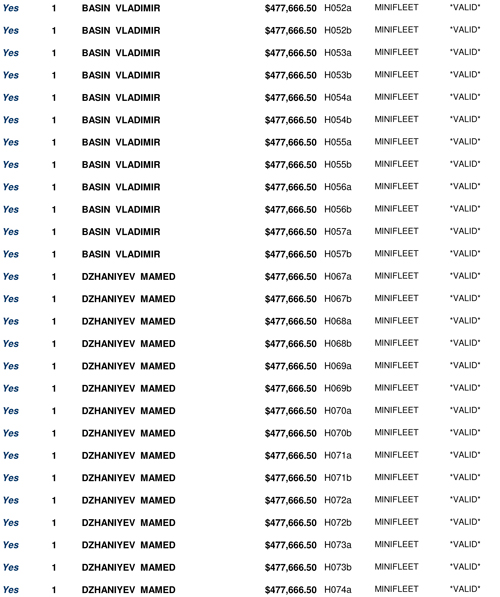
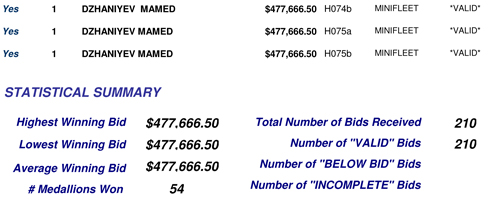
NYC
TLC SUCCESSFULLY AUCTIONS 254 ALTERNATIVE FUEL TAXICAB MEDALLIONS
The New York City Taxi and Limousine Commission (TLC) successfully auctioned
the remaining 254 taxicab medallions, of the 308 slated for sale in
this fiscal year. These medallions are dedicated for use on either Hybrid-Electric
vehicles, or vehicles powered by Compressed Natural Gas. This will increase
the number of “green taxicabs” to 281 from 27, placing New
York City among the world leaders of cities with “green”
taxicabs.
“New York City’s yellow taxicab fleet has become cleaner
and greener due to the sale of 254 alternative fuel medallions, bringing
the total number of ‘clean-air’ taxicabs to 281,”
said TLC Commissioner/Chairman Matthew W. Daus. “Drivers greatly
appreciate the increased fuel economy, and passengers appreciate a more
environmentally conscious mode of transportation.”
The public bid opening is the culmination of a process in which sealed
bids were accepted for the available 130 Independent and 124 Minifleet
medallions between Monday, June 19 and Wednesday, June 21. The seals
for these bids were publicly broken, and the contents processed by a
team of specially trained TLC staff. As the names of bidders and their
pledged amounts were read from a podium, a large screen flashed the
ranking of the bids, allowing prospective new medallion owners to monitor
their progress. The opening took place at 40 Rector Street in Downtown
Manhattan.
Setting the stage for the auction was an announcement on May 18, 2006
by Mayor Michael R. Bloomberg and TLC Commissioner/Chairman Daus of
plans to increase the number of “clean” taxicabs to 254
from 62, a move that was “hailed” by environmental advocates
as a bold step forward in reducing emissions, while providing for greater
fuel economy for drivers.
The event will be televised on NYC-TV in the near future.
PLEASE
NOTE: THE FOLLOWING NUMBERS ARE TENTATIVE AND UNOFFICIAL, PENDING CONFIRMATION
AND PROCESSING
TENTATIVE RESULTS
MEDALLION
AUCTION FAST FACTS
Minifleet
Alt. Fuel
•
Highest Winning Bid: $554,147.50
• Lowest Winning Bid: $500,500.00
• Average Winning Bid: $514,327.71
• Total No. of Bids Received: 169
• Number of "Valid" Bids: 163
Independent
Alt. Fuel
•
Highest Winning Bid: $554,147.50
• Lowest Winning Bid: $500,500.00
• Average Winning Bid: $514,327.71
• Total No. of Bids Received: 169
• Number of "Valid" Bids: 163
A
comprehensive list of tentative winning bidders will be made available
on the TLC’s web site at www.nyc.gov/taxi.
N.Y.C.
T.L.C. CLOSED BID AUCTION TENTATIVE RESULTS: ALTERNATIVE FUEL MEDALLIONS
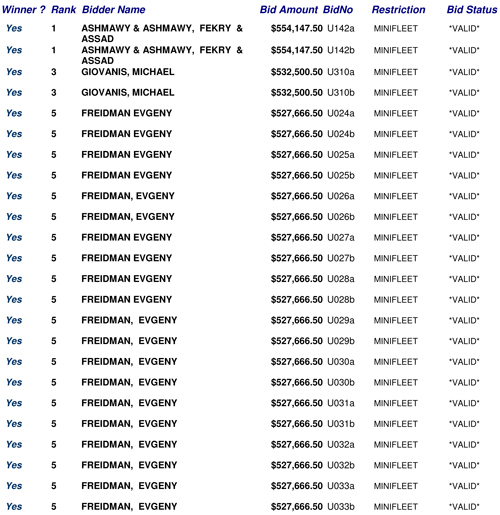
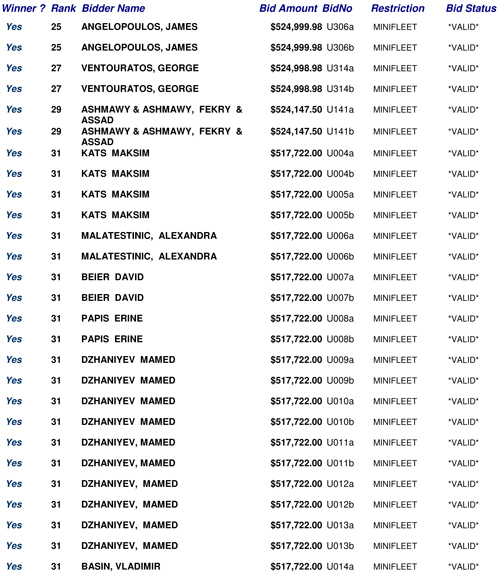
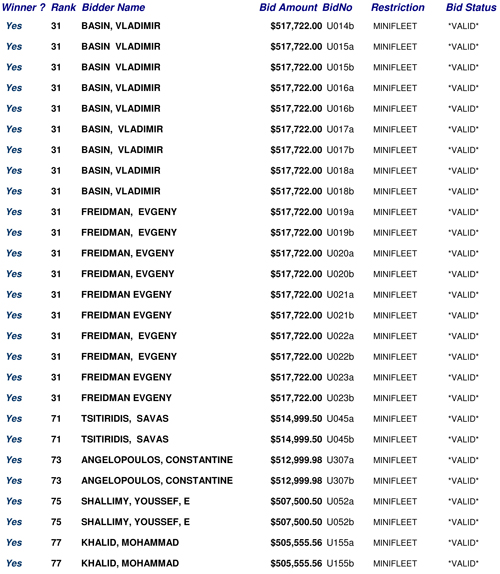
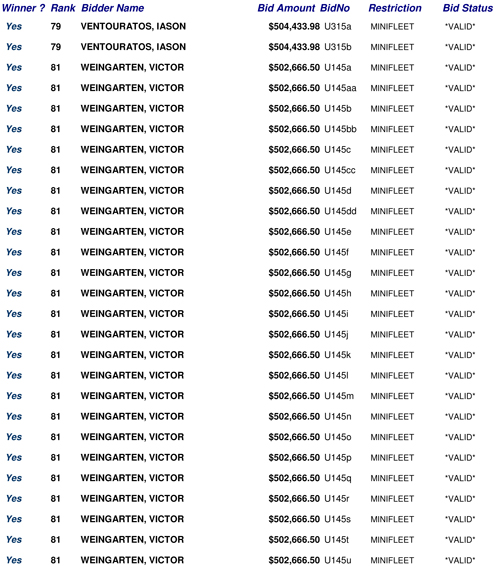

N.Y.C. T.L.C. CLOSED BID AUCTION TENTATIVE RESULTS: ALTERNATIVE FUEL MEDALLIONS
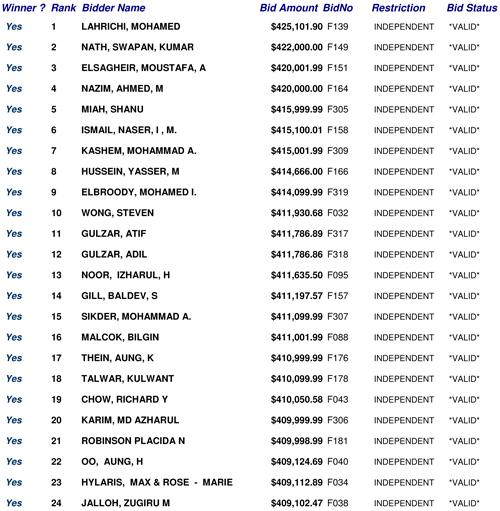

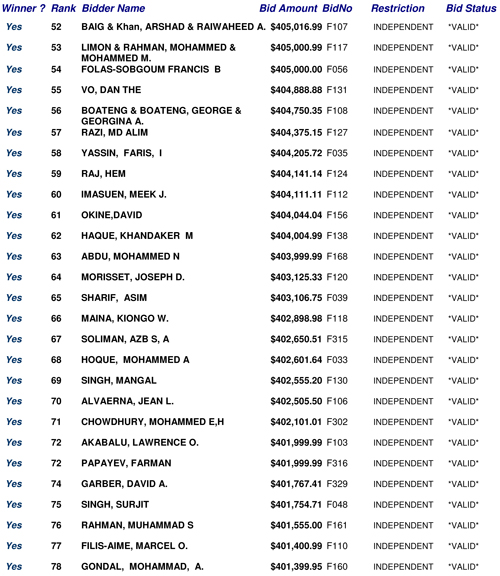
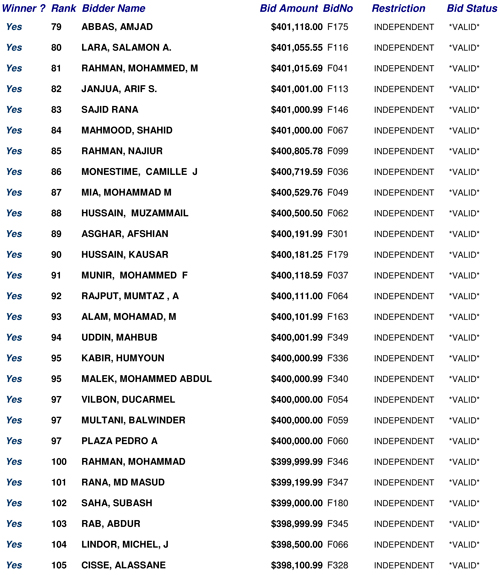
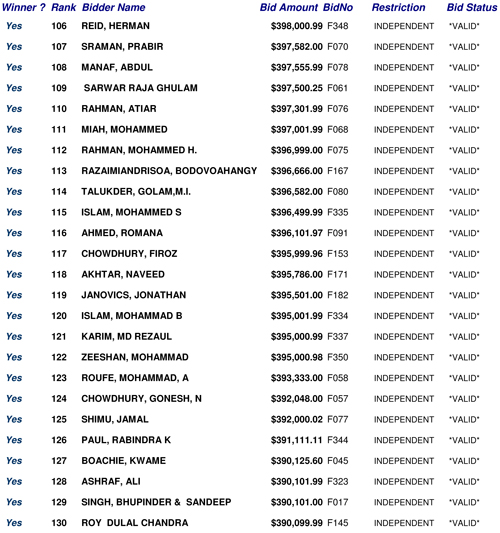

© 2015 TLC Magazine Online, Inc. |